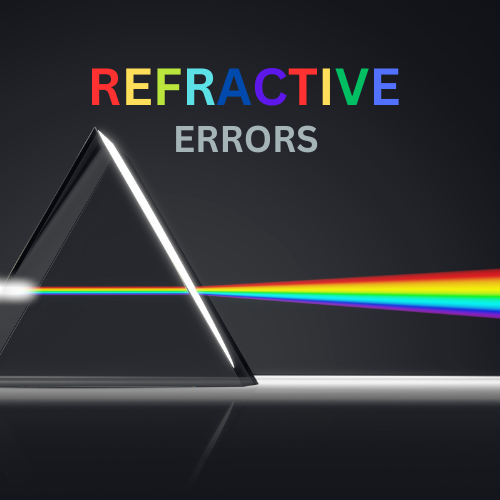What are Refractive Errors?


Refractive errors are “technically” any vision that might be corrected by refraction , or, with the prescription of glasses. Not all changes in vision can be corrected by refraction and not all refractive errors can be corrected with a prescription.
Refractive errors are disorders that affect the way the eye bends light. A refractive error occurs when there is a mismatch between the components of the eye (the cornea and the crystalline lens) and the length of the eyeball.
This mismatch can cause light entering the eye to focus in front of or behind the retina, resulting in blurry vision. The most common symptom is blurry vision. Other symptoms include:
The most common symptom of a refractive error is blurry vision. Other symptoms include:
- Double vision
- Hazy vision
- Seeing a glare or halo around bright lights
- Squinting
- Headaches
- Eye strain (when your eyes feel tired or sore)
- Trouble focusing when reading or looking at a computer
Refractive errors are corrected with eyeglasses, contact lenses, or surgery. Several factors can contribute to the development of refractive errors in the eye:
Corneal Shape: The cornea, the clear front surface of the eye, plays a crucial role in refracting (bending) incoming light. An abnormal corneal shape can cause refractive errors. For example:
Nearsightedness (Myopia): In myopia, the cornea or the eyeball is too steep, causing light to focus in front of the retina instead of directly on it.
Farsightedness (Hyperopia): In hyperopia, the cornea or the eyeball may be too flat, causing light to focus behind the retina.
Crystalline Lens: The crystalline lens inside the eye is responsible for fine-tuning the focus of light. Changes in the shape and flexibility of the lens can lead to refractive errors.
- Presbyopia: As people age, the crystalline lens becomes less flexible and less able to change shape to focus on near objects. This results in difficulty reading and is a common type of farsightedness that occurs with aging.
Axial Length of the Eye: The length of the eyeball from the front to the back is another critical factor. If the eyeball is too long (axial myopia) or too short (axial hyperopia), it can result in refractive errors.
- Axial Myopia: An elongated eyeball causes light to focus in front of the retina.
- Axial Hyperopia: A shorter eyeball results in light focusing behind the retina.
Genetics: Refractive errors often run in families. If one or both parents have myopia, hyperopia, or astigmatism, their children are more likely to develop similar refractive errors. Genetics can influence the shape of the cornea and the development of the eye.
Environmental and Lifestyle Factors: There is some evidence to suggest that environmental factors, such as excessive near work (reading, using digital devices) or limited outdoor time during childhood, may contribute to the development of myopia. However, the exact causes are still under investigation.
Disease or Eye Conditions: Certain eye conditions, like keratoconus (abnormal corneal shape) and cataracts (clouding of the crystalline lens), can lead to refractive errors. Treating the underlying condition can often correct the refractive error.
Refractive errors are the most common type of vision problem. More than 150 million Americans have a refractive error — but many don’t know that they could be seeing better. That’s why eye exams are so important.
Gregory Scimeca, M.D.
Ophthalmologist and Medical Director
The Eye Professionals
Our Locations
